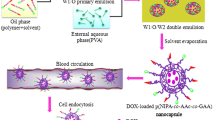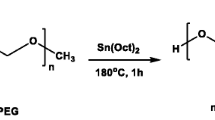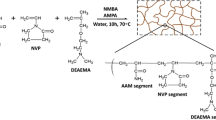Abstract
Two temperature sensitive drug carriers, poly (N-isopropylacrylamide-co-acrylic acid) (PNIPA-co-AA) and poly (N-isopropylacrylamide-vinyl pyrrolidone-acrylic acid) (PNIPA-VP-AA), were successfully synthesized through free radical mechanism. The diameters of PNIPA-co-AA and PNIPA-VP-AA particles can be regulated to be less than 100 nm, which were related to surfactant sodiumdodecyl sulfate and initiator ferrous ammonium sulfate, respectively. The lower critical solution temperature (LCST) of them can be manipulated to be higher than 40 °C, which was correlated to amount of acrylic acid (AA) that was copolymerized with NIPA. Hydrophilic anti-tumor drugs, 5-fluorouracil (5-Fu) and hydrophobic drug thalidomide were entrapped into PNIPA-co-AA and PNIPA-VP-AA, respectively. For different interaction mechanism between drug and carrier, 5-Fu was prone to be entrapped in PNIPA-co-AA with loading efficiency larger than 10% (w/w), while thalidomide was entrapped in PNIPA-VP-AA up to 80% (w/w). Fluorescein, an angiography agent, was used to evaluate the drug loading mechanism between PNIPA-VP-AA and poor water-soluble drug. In vitro drug release behavior from these two drug carriers were significantly different and showed temperature dependent, which demonstrated that PNIPA-co-AA and PNIPA-VP-AA are promising candidates for different controlled drug delivery system.







Similar content being viewed by others
References
N. MAEDA, S. MIYAZAWA, K. SHIMIZU, T. ASAI, S. YONEZAWA, S. KITAZAWA, Y. NAMBA and H. TSUKADA, N. Oku, Biol. Pharm. Bull. 29 (2006) 1936
S. L. BERG, C. BRUECKNER, J. G. NUCHTERN, R. DAUSER, L. MCGUFFEY and S.M. BLANEY, Cancer Chemother. Pharmacol. 5 (2006) [Epub ahead of print]
H. Y. JIANG, S. H. SHA and J. SCHACHT, J. Neurochem. 99 (2006) 269
M. T. CIBEIRA, L. ROSINOL, L. RAMIRO, J. ESTEVE, M. TORREBADELL and J. BLADE, Eur. J. Haematol. 15 (2006) [Epub ahead of print]
D. S. DOSS, Clin. J. Oncol. Nurs. 10 (2006) 514
H. R. MOGHIMI, A. C. WILLIAMS and B. W. BARRY, J. Pharm. Pharmacol. 50 (1998) 955
T. METZ, T. HAQUE, H. CHEN, S. PRAKASH, D. AMRE and S. K. DAS, Drug Deliv. 13 (2006) 331
A. KADER and A. PATER, J. Control. Release 80 (2002) 29
H. H. BACKUS, H. M. PINEDO, D. WOUTERS, J. M. PADRON, N. MOLDERS, C. L. VANDERVILT, C. J. VAN GROENINGEN, G. JANSEN and G. J. PETERS, Int. J. Cancer 87(2000) 771
S. HIROTSU, Y. HIROKAWA and T. J. TANAKA, Chem. Phys. 871 (1987) 1392
R. H. PELTON and P. CHIBANTE, Colloids. Surf. 20 (1986) 247
J. E. CHUNG, M. YOKOYAMA and T. OKANO, J. Control. Release. 65 (2000) 93
X. HUANG and T. L. LOWE, Biomacromolecules 6 (2005) 2131
X. H. XIA, Z. B. HU and M. MARQUEZ, J. Control. Release. 103 (2005) 21
D. E. MEYER and B. C. SHIN, J. Control. Release. 74 (2001) 213
C. S. CHAW, K. W. CHOOI and X. M. LIU, Biomaterials 25 (2004) 4297
F. KOHORI, M. YOKOYAMA, K. SAKAI and T. OKANO, J. Control. Release. 78 (2002) 155
M. YOKOYAMA, A. SATOH, Y. SAKURAI, T. OKANO, Y. MATSUMURAB, T. KAKIZOEB and K. KATAOKAC, J. Control. Release. 55 (1998) 219
L. C. LESLIE, N. NITIN and B. GANG, Mater. Today 8 (2005) 32
H. M. YAND and R. RRISFELD, Proc. Natl. Acad. Sci. U.S.A. 85 (1988) 1189
P. THEDREZ, J. C. SACCAVINI and D. NOLIBE, Cancer Res. 49 (1989) 3081
A. K. GUPTA, S. MADAN, D. K. MAJUMDAR and A. MAITRA, Int. J. Pharm. 209 (2000) 1
R. MOHAN, K. RAMANAN, P. CHELLAMUTHU, L. P. TANG and K. T. NGUYEN, Biotechnol. Prog. 22 (2006) 118
M. W. DEWHIRST, Int. J. Hyperthermia. 10 (1994) 339
P. M CORRY and E. P. ARMOUR, Int. J. Hyperthermia. 21 (2005) 769
Acknowledgements
The authors are grateful to Natural Science Foundation Committee of China (NSFC30371362, NSFC 30672015), the Ministry of Education of China and China Pharmaceutical University for their financial supports.
Author information
Authors and Affiliations
Corresponding author
Rights and permissions
About this article
Cite this article
Chen, H., Gu, Y. & Hu, Y. Comparison of two polymeric carrier formulations for controlled release of hydrophilic and hydrophobic drugs. J Mater Sci: Mater Med 19, 651–658 (2008). https://doi.org/10.1007/s10856-007-3019-4
Received:
Accepted:
Published:
Issue Date:
DOI: https://doi.org/10.1007/s10856-007-3019-4




